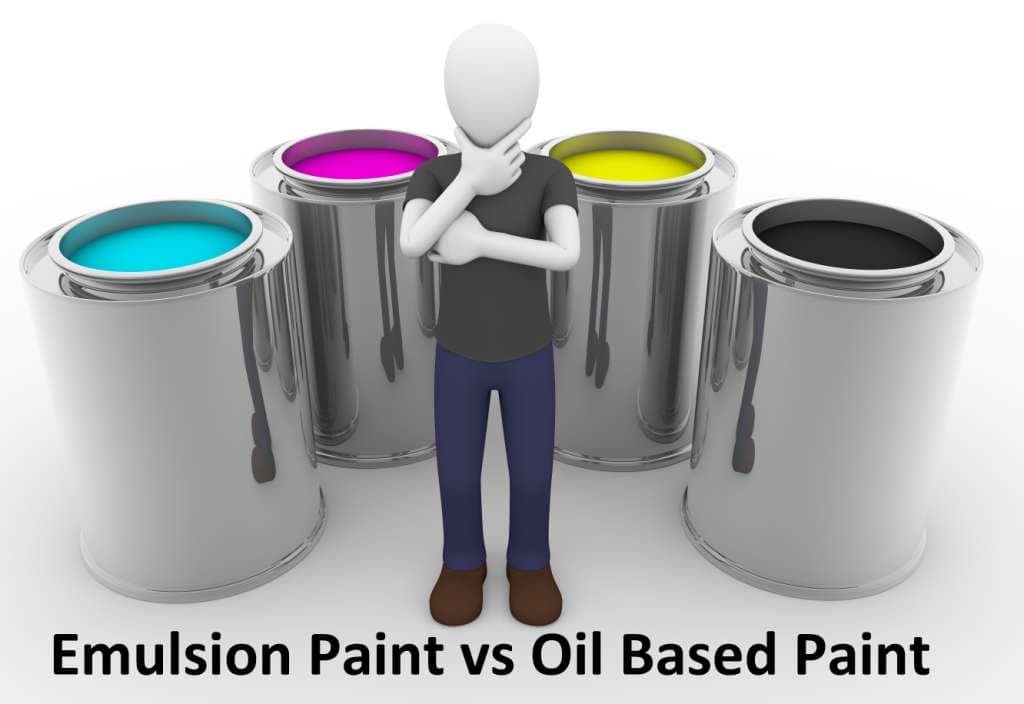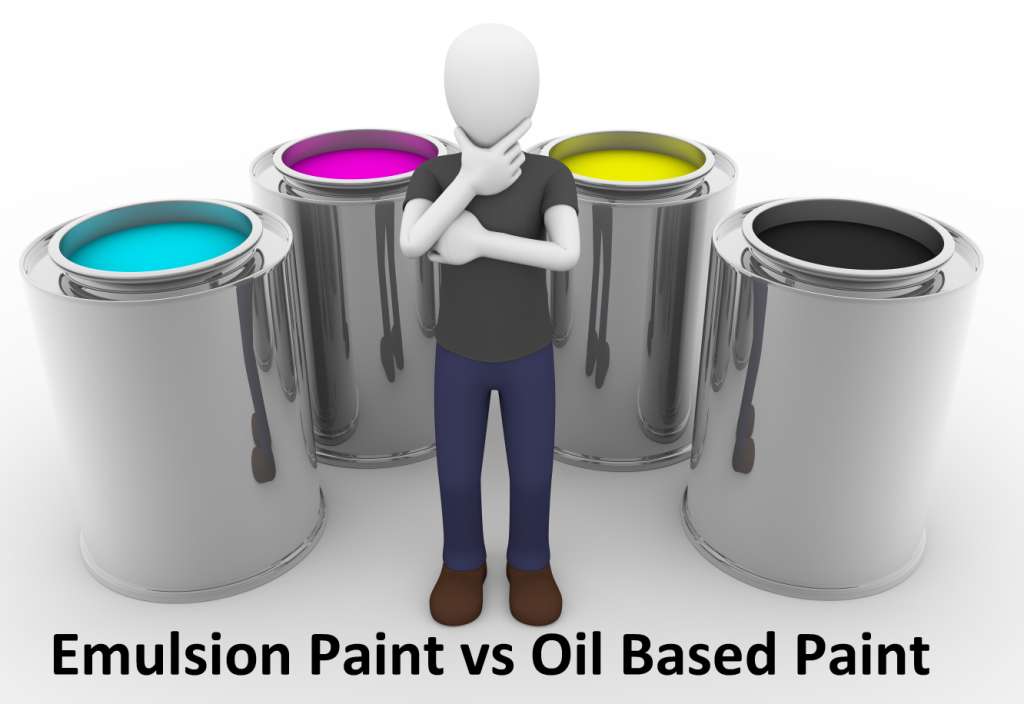
Paints are normally marketed by multinational companies. Nowadays latest paints are available in the market such as Emulsion paint,oil based paint, distemper paint, cement base paint, enamel paint etc. Selection of right paint therefore is the very important task.
Emulsion as well as oil based paints are the popular paints for decorating home. These paints have different properties, availability and cost. Hence, here in we give you a brief comparison between Emulsion paint & oil based paint to help you to make the right choice.
The basic composition of paint is base, solvent, thinner, binder, pigment and additives. Binder is the main composition of paint and solvent is a medium where binder, pigment and additives are dispersed in molecular form. All paints differ due to their basic composition.

01. General
- Emulsions are defined as a mix of two liquids which do not mix well. Two liquids can form different types of emulsions. As an example, oil and water can form two type emulsions. The first part is the oil-in-water emulsion, where the oil is in the dispersed phase and water is dispersion medium. The second part is water-in-oil Emulsion, where water is in the dispersed phase and oil is the external phase.
- Oil based paints are slow drying paints which consist of particles of pigment suspended in a drying oil or oil varnish as the basic vehicle ingredient. The commonly available oils are linseed oil, Tung oil, poppy oil, nut oil. Oil based paints contain thinners like turpentine, naphtha, Methyl ethyl ketone, etc.
Also Read: Basic Component of Emulsion Paint
02. Composition of Paint
(a) Base
- The Base of Emulsion paint usually consists of white lead/red lead, zinc oxide, iron oxide, titanium white, aluminium powder, litho phone, etc.
- The Base of oil based paint also usually consists of white lead/red lead, zinc oxide, iron oxide, titanium white, aluminium powder, lithophone, etc.
(b) Solvent
- Water is used as a solvent in emulsion paint.
- No need of solvent in oil based paint.
(c) Thinner
- No need of thinner in Emulsion paint.
- Turpentine, naphtha, white sprit etc are used as thinner.
(d) Binder
- Binders used in emulsion paints are resin such as alkyd resins, acrylic resin, epoxy, etc.
- Oil likes linseed oil, tung oil, poppy oil, nut oil are used as binder.
(e) Pigment
- Pigments are coloring materials added to the paint to impart the desired shade & color. Pigment is used as per paint chemistry. Pigments are also used to hide the surface imperfections.
- Pigments are coloring materials added to the paint to impart the desired shade & color. Pigment is used as per paint chemistry. Pigments are also used to hide the surface imperfections.
(f) Additives
- Additives are used in paint as per ultimate properties desired. Emulsifiers are wetting agents which increase the colloidal stability of the paints in the liquid state.
- Additives are used in paint as per ultimate properties desired. dries are used in oil based paint to accelerate drying of paint by catalyzing the oxidation of the binder.
03. Properties of Paint
(a) Finish of Paint
- Emulsion Paints have different finishes such as matt, smooth, eggshell, semi-glossy and glossy.
- Oil based paints have different finishes such as high gloss, smooth and opaque.
(b) Drying Time
- Quick Drying
- Takes time to dry
(c) Dour of Paint
- Emulsion Paint has a light odour.
- Oil based paint has a strong odour.
(d) Durability of Paint
- Emulsion paint is more durable than other paints. It does not fade and crack with time.
- Oil based paint is less durable than the emulsion paint. It may turn yellow and crack with time.
(e) Washability
- Washability of emulsion Paint is good. Hence the surface painted with this paint can be easily cleaned with water.
- Washability of oil based paint is average. Hence the surface painted with this paint can’t be easily cleaned with water.
(f) Coverage of Area
- One litre of paint will cover 100-160 sft of area for two coats of emulsion paint.
- One litre of paint will cover 100-130 sft of area for two coats of oil base paint.
(g) Available Packs
- Emulsion Paints are available in 1 ltr, 4 ltr, 10 ltr, 20 ltr packs.
- Oil based paint are available in 500ml, 1 ltr, 4 ltr, 10 ltr, 20 ltr packs.
Also Read: All You Need to know about Emulsion Paint
04. Application of Paint
- Emulsion paint is easy to apply. It can be applied by brush, roller and spray.
- Oil based paint is also easy to apply. It can be applied by brush, roller and spray.
05. Recommend Area
- Emulsion paint can be used both for exterior as well as interior surfaces.
- Oil based paint can also be used for both exterior and interior surfaces.
06. Surface for Apply Paint
- Emulsion paint can be applied on old as well as new plastered surface. It is also applied on metal, wooden furniture, glass, and concrete.
- Oil based paint can also be applied on old as well as new plastered surface. It is applied on metal, wood work and aluminium surface.
07. Advantages
- Emulsion paint is hard and can be easily cleaned by washing with water. Contact with water will not affect the colour or quality of emulsion paint.
- All application techniques can be used such as brushing, spraying, dip, flow, and roller.
- The emulsion paint is less odorous and non-inflammable hence it is safe for our health.
- Emulsion paints don’t crack or fade in the sunlight. Emulsion paints are less likely to attract the growth of mildew on it.
- Emulsion paints have humidity – resistance and hence can be easily used in steamy rooms like kitchens and bathrooms.
- Emulsion paints use water as the medium which carries the colour pigment to the surface that is being painted. By the time the paint dries, the water evaporates completely. These paints have very little risks for humans and animals around because the only thing that evaporates and enters the air is hydrogen and oxygen. Hence it has less volatile organic compound.
- They are flexible hence suitable as external paint where volumetric changes happen due to temperature variations. Hence more waterproof, as they will not easily crack.
- Oil based paint have high glossy finish.
- It is hard and more durable finish but not as hard as emulsion paint.
- Oil based paint has an excellent adhesion property.
- Oil based paint is thicker hence surface requires less number of coats.
- Oil based paint is available in variety of colors and it is also available in different finishes ranging from high gloss to Matt.
- It is less expensive as compared to emulsion paint.
Also Read: Pros and Cons of Emulsion Paint
08. Disadvantages
- Emulsion paints have low drying rate at high humidity.
- Emulsion paints are more expensive than the other paints.
- Oil based paint have a high volatile organic compound. i.e toxic compounds and hence injurious to health.
- It is made with toxic materials which affects the eye, can cause lung and skin irritations along with a headache and weakness.
- Oil based paint have more drag and hence take time to dry.
- Oil based paint attract dirt and insects when in wet condition.
- Oil based paints are made from vegetable oils which give needed food to the mildew to grow.
- Oil based paints have a strong odour and are flammable.
- They are less flexible and hence they can’t be used on external surface as they will crack due to temperature variations. Hence not waterproof.
Conclusion
Emulsion paints are mostly used than oil based paint because oil based paints are made from harmful solvents and injurious chemicals. Hence emulsion paints are gaining vast popularity with the public’s efforts to avoid using paints that involve harmful solvents and dangerous chemicals in its application and cleanup.
Also Read:
Difference between Paint and Primer
Steps to Check Quality of Painting






























